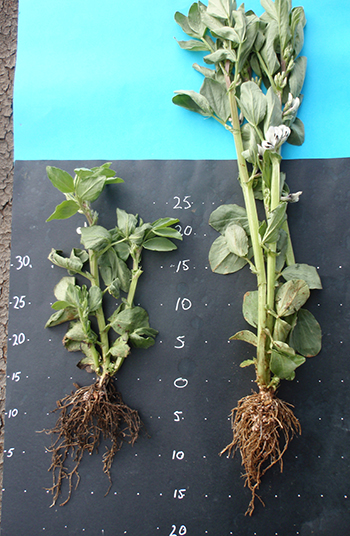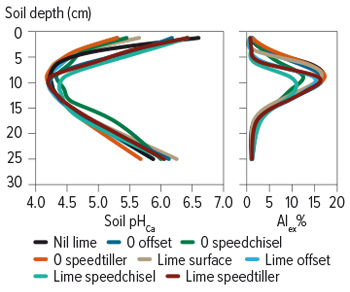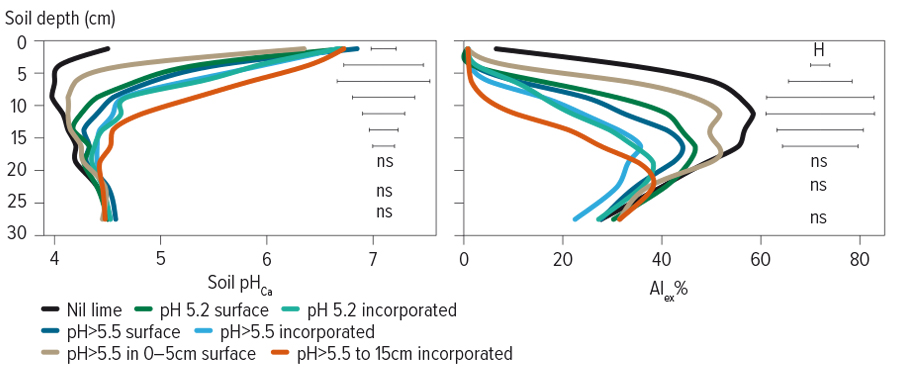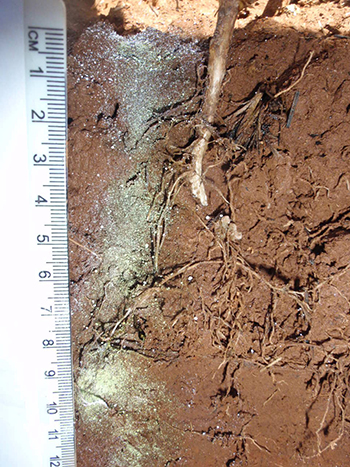Key points
- Traditional liming practices cannot be relied on to stop acid layers from forming in productive soils
- Check crops and pastures for poor growth areas
- Dig up any stressed plants and inspect the roots
- Poor vigour, stunted root growth and/or poor nodulation could indicate an acid soil constraint
- Use a soil pH test kit to check and compare soil pH profiles from areas of good and poor growth
- Collect soil samples in five-centimetre increments to a depth of at least 20cm
- Send the samples to an accredited laboratory for testing for pH, aluminium percentage and cation exchange capacity
- The test results will confirm the depth and severity of acidic layers
- Use the test results to develop a targeted acid soil management program
- Incorporate lime to the depth of the acid layers, if possible
- Where acidity is deeper than the depth of lime incorporation, or if incorporation is not possible, maintain a soil pHCa of more than 5.5 in soil overlying the acid subsurface layers
- Lime will not move unless soil pHCa is above 5.5
Taking action to address soil acidity effectively will ensure this costly constraint does not reduce profit.
Paddock surveys and on-farm trials indicate that traditional liming practices are not alleviating acidity below the surface layer.
The research investigating effective acid soil management is a collaboration between the New South Wales Department of Primary Industries (DPI), Charles Sturt University, FarmLink Research, the Grasslands Society of NSW, Holbrook Landcare Network, Central West Farming Systems, K-Line Ag, Westlime and the Australian National University.
The work is collated in a National Landcare Program Smart Farming Partnership project, supported by the Australian Government, called FutureSOILS.
GRDC has also recently made investments that build on the work of the FutureSOILS project, which aims to update acid soil management practices and extend the work into western NSW through Ag Grow Agronomy and Research and Charles Sturt University.
 The faba bean plant on the left was grown in soil with a pHCa of 4.2 at five to 20 centimetres. The faba bean on the right was grown in soil with a pHCa of 5.0 to 5.2 at a depth of five to 20cm. Photo: Helen Burns
The faba bean plant on the left was grown in soil with a pHCa of 4.2 at five to 20 centimetres. The faba bean on the right was grown in soil with a pHCa of 5.0 to 5.2 at a depth of five to 20cm. Photo: Helen Burns
Common practice is to lime paddocks when the pHCa of the surface 10 centimetres of the soil drops below 4.8, and to apply enough lime to target a pHCa of about 5.2.
However, the most-acidic layers of the soil profile are commonly within the five to 20cm depth. This is a problem because growers who are following the old acid soil management approach are thinking they have addressed the problem, yet the production-limiting acidity remains in the profile, often undetected.
Outdated advice
In the late 1980s, when soil acidity was widely diagnosed in southern NSW, interest rates were 17 to 18 per cent, while the average land cost was about $300 to $400 a hectare. Lime costs were about $60/tonne applied.
At that time, the message was ‘if you can increase pHCa to 5.2 in the 10cm surface layer by adding lime, you eliminate aluminium toxicity and the plants are not affected’.
It encouraged farmers to lime about every 10 years and then applying about 2.5t/ha to increase the pHCa above 5.0.
There are now several problems with this approach.
First, back then people incorporated lime before they sowed, resulting in lime being mixed through the soil, making it more effective within the topsoil.
Second, often lime was not applied until growers saw obvious symptoms of acid soil toxicity, by which time crops had already suffered a grain yield penalty.
Third, when just enough lime is applied to acidic soils to increase soil pHCa above 5.0 and remove toxic aluminium, the lime is consumed where it is placed.
Fourth, farming systems are now much more productive than they were in the late 1980s. Higher product removal in grain, hay, dual-purpose crops, and larger nitrogen fertiliser inputs all act to increase the acidification rate above those estimated just 20 years ago.
Fifth, soil surveys show that traditional liming rates of applying 2.5t/ha once every 10 years in minimum-tillage systems are not keeping up with acidification rates. Even in paddocks with a long lime history, under minimum tillage where lime is surface-applied and only incorporated by sowing, a soil pHCa target of 5.2 has not increased pH below a soil depth of about 7.5cm.

Lentil roots (left) where lime was not applied with an acid layer (pHCa 4.5) at five to 15cm. The lentil roots on the right were growing in soil that had been ameliorated and pHCa had increased to a depth of 10cm. Photo: Karl Moore
Fieldwork near Wagga Wagga, NSW, from 1992 to 2010 demonstrated that pHCa needed to be more than 5.5 for the lime effect to move below the depth of incorporation. However, that research was done on highly acidic soils (pHCa of just over 4.0). Achieving a pHCa of more than 5.5 required about 8t/ha of lime, which was not economical at that time. Accordingly, growers decided it was cheaper to buy more land than it was to lime any higher than pHCa 5.2.
Research outcomes
Several important findings have emerged from the recent acid soil management research in NSW.
While pre-sowing incorporation is critical to mix lime through the soil profile, FutureSOILS research demonstrated that none of the machines tested mixed lime to the depth of incorporation.
By way of example, consider the FarmLink-run FutureSOILS trial site near Grenfell, NSW, where, so far, there has been no yield response in the wheat crop sown immediately after applying 7t/ha of superfine, high-neutralising-value lime in 2021 (see Figure 1).
Figure 1: Soil pHCa at FarmLink’s Grenfell, NSW, FutureSOILS trial site in 2021.

Source: FarmLink and Charles Sturt University
The lack of grain yield response was explained when researchers sampled the soil and discovered the incorporated lime had not reached the acid soil band located in the subsurface layers, below 10cm.
Cultivation ripped through the acid layer but none of the machines sufficiently mixed the lime to neutralise acidity in the 10 to 15cm layer.
The acid layer is still there, and there is no current grain yield response – at least not yet.
A soil pHCa of more than 5.5 should allow excess alkali to gradually move down with time to remove the acidity, and the incorporated treatment will have a good head start compared to the surface-applied lime that was not incorporated.
There would still be unreacted lime in the profile 12 months after application, so researchers are waiting on the 2022 data to see what happened over the past year.
In previous long-term research, pHCa increased at 0.04 units per year in the 10 to 20cm layer when the 0 to 10cm layer was maintained above a pHCa of 5.5 with adequate lime application. Alkali movement is possible but very slow and conditional.
Figure 2: Soil pHCa and exchangeable aluminium percentage at the Lyndhurst, NSW, field trial. Data are from the 2021 sampling. Trial established in 2020.

Source: Helen Burns and Jason Condon
Figure 2 shows that effective incorporation on a highly acidic site at Lyndhurst, NSW, increased pHCa to depth compared with the same rate that was surface applied.
The highest lime rate in Figure 1, indicated by the green line, was most effective at changing pHCa one year after application. This treatment achieved a pHCa of 5.5 to a depth of 10cm and should continue to increase pH below this depth into the future.
By aiming to increase pHCa to more than 5.5 in the top 15cm, the intent is that excess alkali will move down to increase pHCa above 5.0 below 20cm in the next few years.
Note also that the lower rate of 2.8t/ha has no effect below 5cm and has only increased pHCa above 5.5 in the zero to 2.5cm layer one year after application.
Acidity indicators
- Crop variability (poor patches) or disappointing grain yields could indicate a possible acidity ‘throttle’, which can be corrected with lime.
- Winter and early spring are ideal times to pull up plants and look for stunted root growth. Check the roots to see how plants are responding to the soil conditions down the profile.
- In legumes and canola, acid soils are often indicated by poorly developed roots that may grow in a ‘j-shape’. These roots are unlikely to extract moisture at depth in dry conditions.
- A lack of nodules on legume roots is another biological indicator that acidity could be a problem.
- Using a Dig Stick and colourimetric pH test kit (equivalent to pH measured in water) will indicate the depth and extent of acidity in the soil. Anywhere poor root growth coincides with yellow or pale green indicator colours is a signal that acidity is likely to be constraining crop growth.
When acidity is suspected in the top 20cm of soil, particularly if there are plans to grow acid-sensitive plants in the next few years, it is worth collecting soil samples in 5cm intervals to a depth of 20cm. Send the samples to a lab for analysis of pHCa, cation exchange capacity and aluminium percentage.
 Root development of chickpeas was restricted below eight centimetres. Testing showed a soil pHCa of 4.6. Photo: Helen Burns
Root development of chickpeas was restricted below eight centimetres. Testing showed a soil pHCa of 4.6. Photo: Helen Burns
The current practice of sampling soil in 10cm intervals will hide the severity of pH in the subsurface layers, especially where there is a history of surface-applied lime.
Taking samples in 10cm increments mixes all the soil in that layer, whereas, in reality, roots encounter soil layers with different pHs within 10cm intervals. For example, even a narrow acid band at 10 to 15cm will reduce nodule formation and function, and so limit nitrogen fixation potential.
Knowing the depth and severity of the acidic layers will inform the need for deeper incorporation and how much lime is needed to deal with the problem.
Recommendations
Acid soil management programs must be updated to manage and/or prevent subsurface acidification. Soil testing every two to three years is the best way to determine if your liming program is effective in increasing soil pH and preventing subsurface acidification.
Based on the latest research, the new recommendation is to target a pHCa of 5.8 in the soil layers that sit over an acidic subsurface layer.
For example, where pHCa is below 5.0 in subsurface layers below 10cm, keeping pHCa over 5.5 in the top 10cm will ensure the alkali from the lime moves into the deeper acid soil layers.
Incorporation will fast-track the amelioration of subsurface acidity. This is particularly relevant if soils are acidic to depth, such as at the Lyndhurst site.
Maintaining pHCa above 5.5 so that the alkali will gradually increase pH beneath the depth of incorporation will require monitoring of soil pH and follow-up lime applications.
The rate of movement down the profile depends on soil type, soil pH, rainfall and acidification rate, so predicting the rate of movement and re-liming intervals is difficult and is best informed with bi-annual soil sampling. History has shown that if you have a pHCa of less than 5.5 in a layer, the alkali will not move beyond that layer.
Accordingly, the message in the 1980s should have been ‘fix the problem now by targeting pHCa just over 5.5’.
With land costing about $15,000/ha, the relative price of lime to land is very low compared to the 1980s. While buying more land might be too expensive, fixing the land you have is affordable.
FutureSOIL research will help to answer two questions:
- What is the most effective way to manage acid soils?
- What is the best method to achieve the target pHCa in certain soil layers?
The aim is to produce new tools to assist management.
Lime calculators
Lime calculators require updating, given current farming systems. Growers are dealing with soils that have stratified pHCa, with variations in organic matter and aluminium at depth that can also change the pHCa response to lime.
Information currently used to determine lime rates is based on a table that has a maximum pHCa target of 5.5.
Growers aiming to address acidic layers below 10cm are asking for lime rate calculators that target a pHCa of 5.8 to 6. The FutureSOILS project aims to create a system to determine this.
FutureSOILS research draws on 16 field experiments conducted using a range of funding sources and collaborators to better understand the optimum lime rates needed to ameliorate and/or prevent subsurface acidity.
Researchers are using sites established to investigate the rate of lime movement and re-acidification, but long-term resourcing is needed to track this into the future so models can be refined to predict pHCa change for different farming systems, climates and soil types. Funding is required to monitor plants’ responses to these changes so that the production and returns on investment from effective acid soil management can be quantified.
More information: Jason Condon, jcondon@csu.edu.au; Helen Burns, helen.burns@dpi.nsw.gov.au

























































